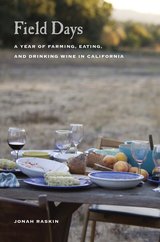Critical Mass regularly features an exemplary review by a National Book Critics Circle member critic. Here, from the San Francisco Chronicle, Regan McMahon reviews Jonah Raskin’s Field Days: A Year of Farming, Eating, and Drinking Wine in California
At the end of the fall semester of 2006, Sonoma State University communications Professor and author Jonah Raskin, about to turn 65, decided he needed to get in touch with the earth and explore his rural surroundings. “Before it was too late,” he writes in Field Days, the account of his yearlong journey among the organic farmers, farmworkers and winemakers of Sonoma County. “Before life passed me by….I wanted to regain something I had lost, and to work alongside men and women who were cultivating the earth. I wanted to eat as though for the first time, with a sense of newness.”
Part scholarly research, part you-are-there journalism and part memoir, his book is filled with stories of people’s lives, heritage and motivations for working the land the way they do. We meet chefs, restaurateurs, farmers’ market produce vendors and organic grocers—such a dizzying cast of characters that some readers may grow weary. But each one’s story is illuminating. Raskin explicitly makes the connection between what we buy at the store or eat at the restaurant and who grew it, picked it and delivered it to your table.
Raskin is no stranger to farm life himself, having grown up in agricultural Long Island in the 1940s and ‘50s—before suburbia edged his family out and his parents moved to Occidental. He plunges in like George Plimpton, a writer playing in the big leagues, beginning his research at farms a short drive from the converted Santa Rosa barn where he lives. In fact, he starts out thinking he’s going to do a book of farm photos, inspired by the many barns he admires in the landscape. Then he moves beyond the aesthetics of farmland to the real working life of the farms he visits.
He not only interviews owners about their operations, their ability to make a profit and why they grow organic, but he also traces the roots of the organic farming movement, which goes back to the 1940s, not, as we might imagine, the 1970s. He lays out the history of cheap migrant labor; the Chinese and the Portuguese toiled the California fields long before the Mexicans did. He tackles the environmentally destructive practices of agribusiness and engages in debates about which is more important: organic or local?
After six months of research, he’s ready to actually work in the fields.
Raskin finds his ideal farm in Glen Ellen, home of Jack London, who was the subject of his 2008 book, The Radical Jack London: Writings on War and Revolution. Oak Hill Farm, owned by organic pioneer Anne Teller, grows vegetables and flowers, which it sells on-site in its Red Barn Store and at the weekly farmers’ market in Sonoma Plaza. Raskin gets permission from Paul Wirtz, who is in charge of the vegetables, to work in the fields for free. He works throughout July and August and waxes ecstatic about the experience:
At the end of the day, after working in the fields, I felt exhilarated and clean to the core of my being—all toxins removed from my body—though I was covered with dirt. Earth was lodged under my fingernails. I lost weight and enjoyed the feel of a tauter, leaner body. I felt younger and more energetic, and I developed a deeper connection to the earth and a more meaningful sense of place than I had had for years.
He learns how to properly pick vegetables from Mexican-born foreman Miguel Barrios and his crew, and flowers from Jesus “Chuy” Soto. He is thrilled when Barrios stops calling him the respectful maestro, and finally calls him Jonas, the Spanish version of his name.
Raskin gets into foodie territory as well, interviewing Craig Stoll of San Francisco’s Delfina and various Sonoma chefs about the farm-to-table movement and describing meals he’s enjoyed. He loves to eat the seasonal local food as much as he loves to pull it out of the ground.
The book’s cover features a photo of a meal he made and shared with friends. But unlike a picture in a glossy gourmet magazine highlighting the beautiful food, this one shows empty dishes and wineglasses, corncobs devoid of kernels, a bread loaf mostly gone: evidence of a well-eaten feast. It’s the perfect shot for a book that focuses on what really matters.


